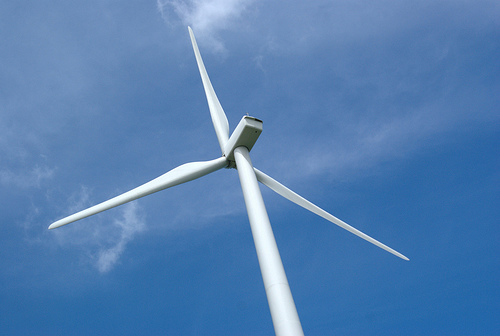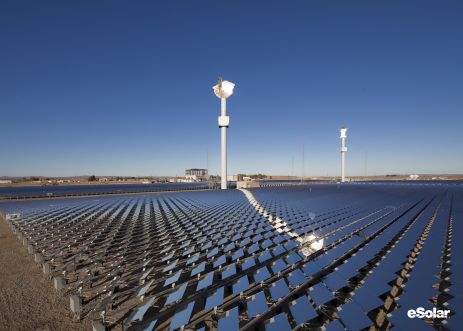During President-Elect Barack Obama’s transition, the Center for American Progress proposed a 10-point clean-energy agenda for the president and Congress that would speed the economic transformation to a clean energy economy. A review of these items today finds that all were adopted or are working their way through the process. This is a startling achievement amidst the worst economy in 70 years, two wars, and an opposition party disinterested in cooperation. President Obama did much of what he promised, and he can do more in 2010 by cajoling Congress to do its part.
These achievements will have real world impact. By 2011, the American Recovery and Reinvestment Act, P.L. 111-5, will double the generation of renewable electricity from the wind, sun, and earth. ARRA will also lead to energy efficiency retrofits in 1 million homes by 2012. And President Obama’s new fuel economy standards would save 1.8 billion barrels of oil. Additional benefits will accrue as the president and Congress finish some 2009 clean-energy initiatives and additional efforts are launched in 2010.
Here’s a review of progress made by the president and Congress over the past year.
1. Wish they all could be California cars
The Bush administration blocked efforts by California and 16 other states to reduce greenhouse gas pollution from motor vehicles. On May 19 of last year, President Obama announced an agreement with California, the auto companies, and the United Auto Workers to establish the first-ever greenhouse gas limits for motor vehicles. The plan would increase fuel economy standards by one-third by 2016, which would save 1.8 billion barrels of oil. It would also cut greenhouse gas pollution by nearly 1 billion metric tons, which is equivalent to removing 177 million cars from the road. The plan should be final in March 2010.
2. Global warming is a real and present danger
The Supreme Court ruled in Massachusetts vs. EPA that the Clean Air Act gives the Environmental Protection Agency the authority to require greenhouse gas reductions from power plants and other sources. But first the EPA has to make an “endangerment finding” that global warming poses a threat to Americans’ health and safety. Despite a recommendation from EPA scientists to do so, the Bush administration refused. Under President Obama, EPA followed the science and the law by making the endangerment finding on Dec. 7, 2009.
In March, EPA should finalize its big polluter rule to focus greenhouse gas reductions on large sources-those facilities that emit 25,000 metric tons of GHG pollution annually. The pollution limits will only apply to about 7,500 facilities, and they’ll exclude farms, small businesses, and other relatively small emitters. Unfortunately, big oil and its allies continue to lie by claiming the EPA pollution reduction rules will apply to farmers and Mom and Pop stores.
3. Green stimulus and recovery
As the economic hurricane gathered force last winter CAP recommended that any recovery plan include $100 billion for clean-energy programs. The American Recovery and Reinvestment Act, or ARRA, which became law on Feb. 17, 2009, includes $70 billion for clean-energy investments in the Weatherization Assistance Program, energy-efficiency in government buildings, states’ efficiency and renewable energy programs, public transit, high-speed rail, advanced battery research, and other programs. ARRA also includes $20 billion in clean-energy tax incentives for residential efficiency measures, wind and solar power, and super-efficient cars. The New York Times called this program “the largest energy bill ever passed.”
The Department of Energy and other agencies adopted safeguards to ensure that these funds are well spent given the unprecedented size and scope of the programs. This took longer than anticipated, so a large portion of clean-energy funds have been allocated but not spent. DOE received $33 billion, nearly half of the clean-energy funds, and it has awarded $23 billion, or about two-thirds of these funds, to eligible states and other grantees. As of December 31, less than $2 billion — or 6 percent — was spent.
The rate of spending, job creation, and energy savings will accelerate in 2010 after the awarded funds are spent. On Jan. 8, for instance, President Obama announced the award of “$2.3 billion in Advanced Energy Manufacturing Tax Credits,” which should leverage another $5 billion in private investments. These funds will go to “One hundred eighty three projects in 43 states [that] will create tens of thousands of high-quality, clean-energy jobs and the domestic manufacturing of advanced clean-energy technologies including solar, wind, and efficiency and energy management technologies.”
Vice President Joe Biden released an analysis in December showing that just two ARRA programs — investments in renewable and smart manufacturing, and smart grid technologies — would create more than 800,000 jobs. And based on past experience the $5 billion ARRA investment in low-income home weatherization projects could create another 160,000 jobs.
4. Mercury falling
The Bush administration’s proposal to delay reductions in mercury pollution from coal-fired power plants was struck down by a federal court because it was less protective of public health than required by the Clean Air Act. The Bush EPA, according to The New York Times, “ignored its legal obligation to require the strictest possible controls on the toxic metal.”
EPA reached a settlement in the lawsuit that led to the mercury rule’s rejection, which would require it to propose mercury limits by March 16, 2011, and finalize the limits by Nov. 16, 2011. Power plants would have to meet plant specific mercury reductions.
5. Curb the enthusiasm for greenhouse gases
Scientists recommend developed countries reduce their greenhouse gas pollution 20 percent below 1990 levels by 2020 to stave off the worst impacts of global warming. They should also reduce emissions 80 percent below 1990 levels by 2050. These reductions should prevent a temperature rise of 2 degrees C.
In order to work more closely with Congress the Obama administration did not propose its own numeric pollution reductions. Instead, it supported House passage of the American Clean Energy and Security Act, or ACES, H.R. 2454, which passed the House of Representatives on June 26, 2009. The World Resources Institute, or WRI, estimates that this bill would achieve an overall pollution reduction of 28 percent below 2005 levels and a 16 percent reduction below 1990 levels. By 2050 it would reduce pollution by 71 percent below 1990 levels.
The administration also supported the Clean Energy Jobs and American Power Act, S. 1733, which the Senate Environment Committee passed on November 5, 2009. WRI estimates this bill would reduce emissions by 17 percent and 68 percent below 1990 levels by 2020 and 2050, respectively. Sens. John Kerry (D-Mass), Lindsay Graham (R-S.C.), and Joe Lieberman (I-Conn.) are developing comprehensive compromise energy and global warming legislation that would reduce greenhouse gas pollution by 17 percent.
6. The answer is blowing in the wind (and shining in the sun)
Twenty-eight states — including the District of Columbia — require utilities to produce a proportion of their electricity from the wind, the sun, the earth’s core, and other renewable sources. In 2008, CAP recommended that President Obama support and Congress pass a nationwide renewable electricity standard of 25 percent by 2025.
ACES would require utilities to generate 15 percent of their electricity from renewable sources by 2020, with utilities allowed to meet 3 percent of the target via energy-efficiency measures. The bill also requires utilities to reduce demand by an additional 5 percent.
 A wind turbine at the Fowler Ridge Wind Farm in Benton County, IndianaVaxomatic via FlickrOn June 17, 2009, the Senate Energy and Natural Resources Committee passed the American Clean Energy and Leadership Act, S. 1462. It would require a 15 percent renewable electricity standard by 2021, which allows utilities to meet 3 percent of this requirement via energy efficiency measures. The bill, however, has a weak enforcement mechanism that may ease noncompliance. An analysis by the Union of Concerned Scientists determined that “the amount of renewable energy required under the RES would be less than this level [15 percent], between 7.4 and 10.7 percent. This is worse-or at best-only marginally better than the amount of renewable energy generated without a national RES.” To significantly boost investments in wind, solar, and other renewable power, the Senate must include a more aggressive renewable electricity standard in its energy and global warming bill expected on the floor this spring.
A wind turbine at the Fowler Ridge Wind Farm in Benton County, IndianaVaxomatic via FlickrOn June 17, 2009, the Senate Energy and Natural Resources Committee passed the American Clean Energy and Leadership Act, S. 1462. It would require a 15 percent renewable electricity standard by 2021, which allows utilities to meet 3 percent of this requirement via energy efficiency measures. The bill, however, has a weak enforcement mechanism that may ease noncompliance. An analysis by the Union of Concerned Scientists determined that “the amount of renewable energy required under the RES would be less than this level [15 percent], between 7.4 and 10.7 percent. This is worse-or at best-only marginally better than the amount of renewable energy generated without a national RES.” To significantly boost investments in wind, solar, and other renewable power, the Senate must include a more aggressive renewable electricity standard in its energy and global warming bill expected on the floor this spring.
7. Bridge loans to the 21st century
General Motors and Chrysler sought federal assistance to prevent bankruptcy after the November 2008 general election. President George W. Bush provided $17 billion in loans before he left office, and President Obama provided another $62 billion to prevent the destruction of the domestic auto industry, which is responsible for 1 in 10 American jobs. During this process, CAP urged that the companies use this assistance to pursue the development, production, and sale of more fuel-efficient automobiles.
The Obama administration provided loans to these two companies with the provision that they restructure their operations and manufacture “the fuel-efficient cars and trucks that will carry us towards an energy-independent future.”
GM’s assistance and restructuring plan requires it to “have a significant focus on developing high fuel-efficiency cars that have broad consumer appeal because they are cost-effective, have good performance and are reliable, durable, and safe.” Chrysler’s merger with Fiat “could lead to Chrysler manufacturing fuel-efficient vehicles using Fiat’s technology.”
Last year the federal government also launched a “cash for clunkers” program to help speed the recovery of the auto industry, create jobs, and reduce oil use. It created an economic incentive to spur the trade in of old gas guzzlers for new, efficient models, and 700,000 clunkers were taken off the roads. The Department of Transportation determined that the average fuel economy of the new cars was 9 miles per gallon more-nearly a 60 percent improvement. The program also saved or created more than 40,000 jobs.
8. Pick the low-hanging energy fruit
Energy efficiency is called the “low-hanging fruit” of clean energy since technology can be employed in myriad ways to reduce energy consumption and also save money. Efficiency would also reduce global warming emissions to boot. Last year, CAP proposed several new efficiency programs including incentives for states to put energy efficiency on equal footing with new power plants; establishment of a federal “energy efficiency resource standard” that requires utilities to reduce energy consumption; and fully funding the Deployment of Combined Heat and Power Systems, District Energy Systems, Waste Energy Recovery Systems, and Efficient Industrial Equipment program to capture and reuse industrial waste heat.
 Photo courtesy kimberlyfaye via Flickr The Obama administration understands the economic and energy benefits of efficiency, and it demonstrated this by investing significant resources in it over the past year. ACES, which the administration supports, includes a 5 percent energy efficiency resource standard. ARRA provided incentives for states to “adopt certain utility regulatory policies to encourage utility-sponsored energy efficiency improvements.” It also included $150 million for nine “combined heat and power” and other industrial waste energy recovery projects. There were 358 other applications for similar eligible shovel-ready projects that would cost $9 billion and create 57,000 jobs. These projects would save the energy equivalent of 160 million barrels of oil annually.
Photo courtesy kimberlyfaye via Flickr The Obama administration understands the economic and energy benefits of efficiency, and it demonstrated this by investing significant resources in it over the past year. ACES, which the administration supports, includes a 5 percent energy efficiency resource standard. ARRA provided incentives for states to “adopt certain utility regulatory policies to encourage utility-sponsored energy efficiency improvements.” It also included $150 million for nine “combined heat and power” and other industrial waste energy recovery projects. There were 358 other applications for similar eligible shovel-ready projects that would cost $9 billion and create 57,000 jobs. These projects would save the energy equivalent of 160 million barrels of oil annually.
ARRA included a total of $25 billion in spending for private efficiency measures and government programs. President Obama also issued Executive Order 13423 to promote “federal leadership in environmental, energy, and economic performance.” It would require federal agencies to slash their greenhouse gas pollution, “increase energy efficiency, reduce fleet petroleum consumption,” and take other steps to promote efficiency and sustainability.
On Dec. 8, 2009, President Obama proposed including residential and industrial efficiency programs as part of any job creation package considered by Congress to combat unemployment. The program would create economic incentives for owners to retrofit their homes or buildings to become more energy efficient. On Dec. 16, the House passed the Jobs for Main Street Act, H.R. 2847, which expands existing energy loan guarantee programs to include large-scale residential and commercial energy efficiency projects. The Senate should include a more vigorous version of the House measure with a “Home Star” or “cash for caulkers” program in its job creation package. The programs would provide economic incentives to homeowners to make their homes more energy efficient via improved air sealing and insulation, advanced building materials, and state-of-the-art appliances. This would quickly create hundreds of thousands of jobs in construction and manufacturing. It would slice participants’ energy bills by 20 percent or more.
9. Green the wires
The lack of transmission capacity is a significant impediment to the broad expansion of renewable energy. Grid modernization must accompany increasing renewable energy generation, including the ability to incorporate intermittent renewable electricity generation. ARRA provided $4.5 billion to DOE for smart grid deployment and transmission line enhancement, and DOE just awarded $60 million for “transmission planning for the country’s three interconnection transmission networks.” This is the first step to enhancing the U.S. electricity transmission network.
What’s more, the American Clean Energy and Leadership Act, includes an “‘interstate highway system’ for electricity by creating a new bottoms-up planning system for a national transmission grid.” The bill allows “states to take the initial lead in deciding where to build high-priority national transmission projects,” but if this process
doesn’t yield siting and construction of high-priority transmission projects then the federal government can step in. This proposal should significantly hasten the planning, siting, and building of new transmission capacity. It should be included in the energy and global warming bill the Senate plans to debate this spring.
10. Rise of the new machines
Research, development, and deployment of new clean-energy technologies were woefully underfunded by the Bush administration. An important element of the clean-energy agenda for the incoming Obama administration was to resume significant investments in the clean-energy technologies of the future. ARRA included nearly $9 billion for the Advanced Research Project Agency for advanced energy technology research, carbon capture-and-storage technologies to remove and store carbon pollution from power plants, advanced batteries, and other projects.
The year ahead
Overall, President Obama’s first year included unprecedented successes and efforts to speed the transformation to a 21st century clean energy economy. In addition to launching the aforementioned investments, he overturned a number of energy decisions made by the Bush administration that ignored sound science while favoring big oil and other special interests.
His success was led by a clean energy all-star team, including Assistant to the President Carol Browner, Agriculture Secretary Tom Vilsack, Energy Secretary Steven Chu, Environmental Protection Agency Administrator Lisa Jackson, Interior Secretary Ken Salazar, NOAA Administrator Jane Lubchenco, and Science Advisor John Holdren.
The unprecedented achievements in year one must continue in year two. The top priority is enactment of comprehensive clean-energy and global warming legislation that would create jobs, increase American energy independence, restore our economic competitiveness, and cut pollution.
To build on the outstanding first year, President Obama and Congress should accomplish the following goals:
- Congress should enact clean-energy jobs and global warming pollution reduction legislation, beginning with Senate passage of a bill.
- The final bill that lands on Obama’s desk should include:
- At least a 17 percent reduction in greenhouse gas pollution by 2020 and an 80 percent reduction by 2050.
- A robust renewable electricity standard.
- Significant investments in energy efficiency.
- Clean-energy job creation programs.
- Significant investments in clean-energy manufacturing competitiveness.
- Jumpstarting electricity transmission siting and construction efforts.
- An independent Clean Energy Deployment Administration (green bank).
- Incentives to increase natural gas use for transportation and electricity with new safeguards for shale gas production.
- Pollution reductions through strong participation in international efforts to cut deforestation in half by 2020.
- Aggressive oil savings measures.
- Strengthen the Copenhagen Accord as a legally binding agreement that makes sure developed and developing nations commit to sufficient pollution reductions to keep global warming to 2 degrees C by 2050.
- Launch a “Home Star” or “cash for caulkers” program as a center element of job creation legislation.
- Make sure EPA finalizes the clean car and major greenhouse gas polluters rules.
- Ensure EPA proposes greenhouse gas pollution limits for large industrial polluters.
Other items on Obama’s energy to-do list should include investing in clean-energy research, implementing efficiency measures, boosting renewable energy production, and implementing clean-energy job training programs. The administration should continue to pursue clean-energy economic development strategies for inner cities and rural areas.
Obama and Congress’ efforts on clean energy over the past year were an unprecedented about face from the Bush administration’s big oil approach. They should continue to speed along the clean energy path this year.



